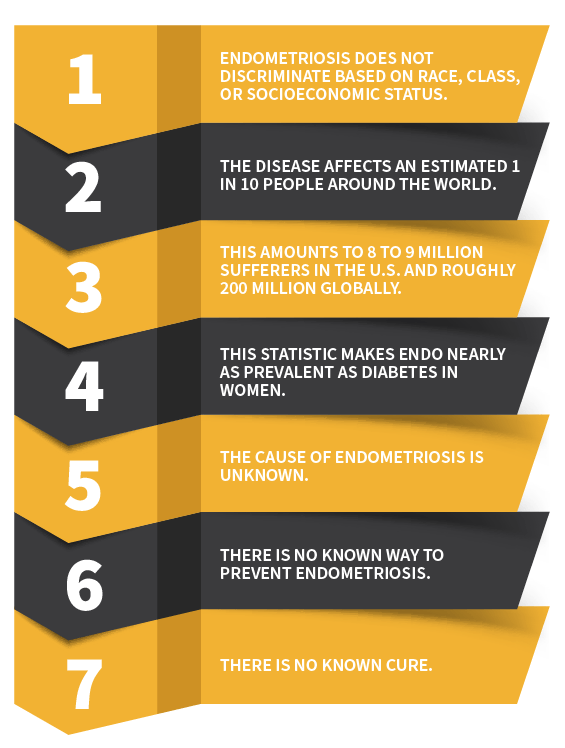
When was the last time you heard about endometriosis in the news? Yet this disease is the third leading cause of gynecologic hospitalization. It’s also among the leading causes of the estimated 600,000 hysterectomies performed in the United States every year.
It’s important to note that a hysterectomy cannot actually cure endometriosis. It’s also important to note that this disease impacts women’s bodies and lived experience (which may account for the dearth of research or research funding), but it can also affect their relationships, families, and work life. Thus, endometriosis should matter more. To everyone.
![]()
Should I Talk to My Doctor About Endometriosis?
Too often, women and teen girls present with symptoms that could signal the presence of endometriosis (sometimes called “endo,” for short), but they are misdiagnosed by doctors. Some of these erroneous diagnoses may include irritable bowel syndrome, celiac disease, or Crohn’s disease.
These patients are then prescribed medications or treatments that do little for their underlying ailment, and some women are merely advised to buy over the counter pain reliever for menstrual cramps. (If your doctor does this, try scheduling an appointment with a gynecologist who specializes in helping patients with endometriosis.)
Even though endometriosis symptoms tend to flare according to the menstrual cycle, endo itself is not caused by periods, nor is the associated pain the same as “normal” cramps. Menstrual cramps do not cause excruciating pain. Endometriosis does.
Sign up to get the latest industry news and offers right in your inbox
Since March is Endometriosis Awareness Month, and the time of year for the global Endo March, this blog sheds light on this painful disease and hopes to raise awareness around the condition and offer support for the people who suffer from it.
What Is Endometriosis, Exactly?
Endometriosis is the diagnosis assigned when tissue inside the uterus starts to grow outside the uterine cavity.
According to the World Health Organization, endometriosis causes a chronic inflammatory reaction in the form of lesions that may result in the development of scar tissue (adhesions, fibrosis) within the pelvis and other parts of the body.
These adhesions often must be removed via surgical ablation, a procedure not without its own set of risks. Several lesion types have been described:
- superficial endometriosis found mainly on the pelvic peritoneum
- cystic ovarian endometriosis (endometrioma) found in the ovaries
- deep endometriosis found in the recto-vaginal septum, bladder, and bowel
The symptoms of endometriosis vary from patient to patient. Debilitating pain is often a commonality among sufferers; however, severity of pain cannot indicate the endometriosis stage.
In summary: “Endometriosis is a chronic disease associated with severe, life-impacting pain during periods, sexual intercourse, bowel movements and/or urination, chronic pelvic pain, abdominal bloating, nausea, fatigue, and sometimes depression, anxiety, and infertility.”
Endo Facts

Money Matters With Endometriosis
Despite such startling statistics, endometriosis receives only pennies on the dollar in federally-funded spending for research and public health awareness campaigns.
In 2017, funding reached 6 million dollars. In 2019, that number was 13 million. In 2022, that number increased to 27 million. This growth is due to vigilant calls-to-action and awareness movements. But it’s not enough.
Though these numbers might sound like a lot of money, it equates to about $2 per woman out of the $41.7 billion global research budget. Two dollars isn’t enough to help anyone.
Did you know? Nearly as many women suffer from endometriosis as diabetes. If endometriosis was funded by the National Institutes of Health (the primary federal agency for conducting and supporting medical research), at just half the level of diabetes, the budget would increase almost 16 times to more than $250 million annually.

What Are Some Symptoms of Endometriosis?
In addition to the most common symptoms listed below, many women with endometriosis suffer from allergies, chemical sensitivities, and frequent yeast infections. They may also experience a range of immune disorders, including asthma, eczema, and certain autoimmune diseases.
Most Common Endo Symptoms:
- Severe pain in lower abdomen before and during periods
- Pain during or after sexual activity
- Painful urination/bowel movements during period
- Fatigue
- Infertility
- Heavy bleeding
- Gastrointestinal upsets (e.g., diarrhea, constipation, and nausea)
The toll endometriosis takes on the body can also lead to a myriad of other health problems not mentioned here.
How Is Endometriosis Diagnosed?
Laparoscopy, an invasive diagnostic procedure, is considered the only definitive method for diagnosing endometriosis. A laparoscopy usually shows the location, size, and extent of the growths. During the procedure, if discussed and authorized beforehand (or during a similar surgery planned for a later time), doctors can remove the endometriotic lesions to hopefully alleviate some of the recurring pain.
While the patient is under general anesthesia, the doctor removes all visible endometriotic lesions and repairs any damage to organs and other sites caused by endometriosis, with the goal to restore the patient’s normal anatomy. However, it is common for the lesions to grow back, and there are other risks associated with ablations.
Please note: Endometriosis is not the same thing as endometrial cancer, even though they can have similar symptoms. Talk to your doctor for more information.
Get the Endo Help You Need—and Deserve
Anyone Suffering from Endometriosis: Talk to your doctor or a physician who specializes in endometrial ablations. The Endometriosis Association offers support, information, and free resources to help you in your journey. Among several forms of treatment they discuss, they also recommend positive coping mechanisms to help you stay strong while you get the medical help you need. These coping mechanisms may work wonders when no one seems to understand what you’re going through.
Teens and Parents of Teens: Dealing with endometriosis as a teenager can be uniquely challenging. There are times when the disease may interfere with almost every area of life, including school attendance, concentration, energy level, social life, physical activities, and self-confidence. Issues like poor concentration, pain, fatigue, nausea, or surprise bleeding can make learning difficult. It might help for parents to talk with school administrators about the diagnosis, as well as provide a doctor’s note for any missed class.
Healthcare Providers: Want to give the help patients need? Plan to attend next year’s Virtual Endometriosis Conference. The free 2024 conference was held March 23 and 24 and hosted by Worldwide EndoMarch and the American & Global Congress of Endometriosis Subspecialists (AGCES). Learn from renowned endometriosis pioneers and specialists on topics such as methods of excisional surgical management for endometriosis, encompassing locations such as the bowel, bladder, ureter, diaphragm, lungs, liver, ovaries, nerves, skin, etc. Explore minimally invasive surgical techniques, including those involving robots, lasers, radiofrequency, plasma jet, cold scissors, ultrasound energy, and more.
Ready to join the movement? Learn about different ways to take action by clicking here. It’s time to help yourself . . . and help others.
